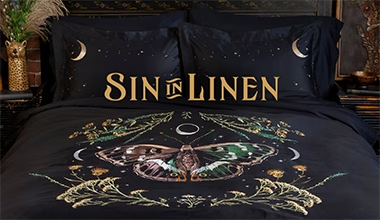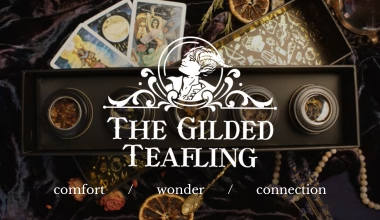Photography by Michaela Ďurišová of her mother Vlasta Gerhardová
–
Feature image: Photographer/Styling: Michaela Ďurišová @michaela.durisova Model: Vlasta Gerhardová @gerhardova
Crowns: Magaela Accessories @magaela_accessories Dresses: Sicilystyle.sk_bystricky_kraj (cover, p. 12-13)
@sicilystyle.sk_bystricky_kraj, linnenaive (p. 14) @linennaive Wings, muah: (p. 11, 15, 17, 70-71) Barbora Baška Slovaková Muah: Dominika Tosh (p. 14)
Tell us a story, you said—you and you and you. Youngest sister, with your green-gold hair and laughter like birds at dawn; next-to-youngest, with your solemn smile and eyes like forest pools shadowed by ancient oaks; next-to- oldest, with your nut-brown cheeks and berry-red lips, your quick and nimble hands that can spin a spider’s web. Tell us a story, oldest sister.
And I said, Have I told you about the Wise Woman of the Forest?
No, you haven’t. Tell us. Tell us. Tell us.
There is a wise woman who lives in the forest, I said. She has lived there since the beginning of time, or maybe just before time began. It’s entirely possible that one morning, as she was sipping her cup of time, one of her cats knocked it out of her hands while trying to nuzzle her chin. Did I mention that she has cats? Of course she has cats. One of them, whose fur is as soft and gray as mist, knocked her cup over and all the time ran out. That is why we have time.
But not much time, said the youngest, because you told us we have to go to bed.
Hush, said the next-to-youngest. Let our sister tell her story.
This is the story I told you.
Deep in the forest there is a castle. It is made of gray stone and surrounded by a gray stone wall. It’s not a large castle, but it is a castle nevertheless, with towers and turrets and battlements. On top of the towers are pennants waving in the breeze, with the pattern of a black cat rampant, and on top of the turrets are peaked round roofs like witches’ hats.
The outer wall has four gates. At the eastern gate, you will be greeted by a white cat, at the southern gate by a ginger, at the western gate by a tortoiseshell, and at the final gate, the northern, by a black cat with white paws and a white patch under its chin.
Each cat will ask your business with the Wise Woman of the Forest, and you must state your business as clearly and accurately as you can. Usually the visitors who come are on a quest, and they come to ask the Wise Woman for wisdom. Someone or tell us a story, you said—you and you and you. Youngest sister, with your green-gold hair and laughter like birds at dawn; next-to-youngest, with your solemn smile and eyes like forest pools shadowed by ancient oaks; next-to- oldest, with your nut-brown cheeks and berry-red lips, your quick and nimble hands that can spin a spider’s web. Tell us a story, oldest sister.
And I said, Have I told you about the Wise Woman of the Forest?
No, you haven’t. Tell us. Tell us. Tell us.
There is a wise woman who lives in the forest, I said. She has lived there since the beginning of time, or maybe just before time began. It’s entirely possible that one morning, as she was sipping her cup of time, one of her cats knocked it out of her hands while trying to nuzzle her chin. Did I mention that she has cats? Of course she has cats. One of them, whose fur is as soft and gray as mist, knocked her cup over and all the time ran out. That is why we have time.
But not much time, said the youngest, because you told us we have to go to bed.
Hush, said the next-to-youngest. Let our sister tell her story.
This is the story I told you.
Deep in the forest there is a castle. It is made of gray stone and surrounded by a gray stone wall. It’s not a large castle, but it is a castle nevertheless, with towers and turrets and battlements. On top of the towers are pennants waving in the breeze, with the pattern of a black cat rampant, and on top of the turrets are peaked round roofs like witches’ hats.
The outer wall has four gates. At the eastern gate, you will be greeted by a white cat, at the southern gate by a ginger, at the western gate by a tortoiseshell, and at the final gate, the northern, by a black cat with white paws and a white patch under its chin.
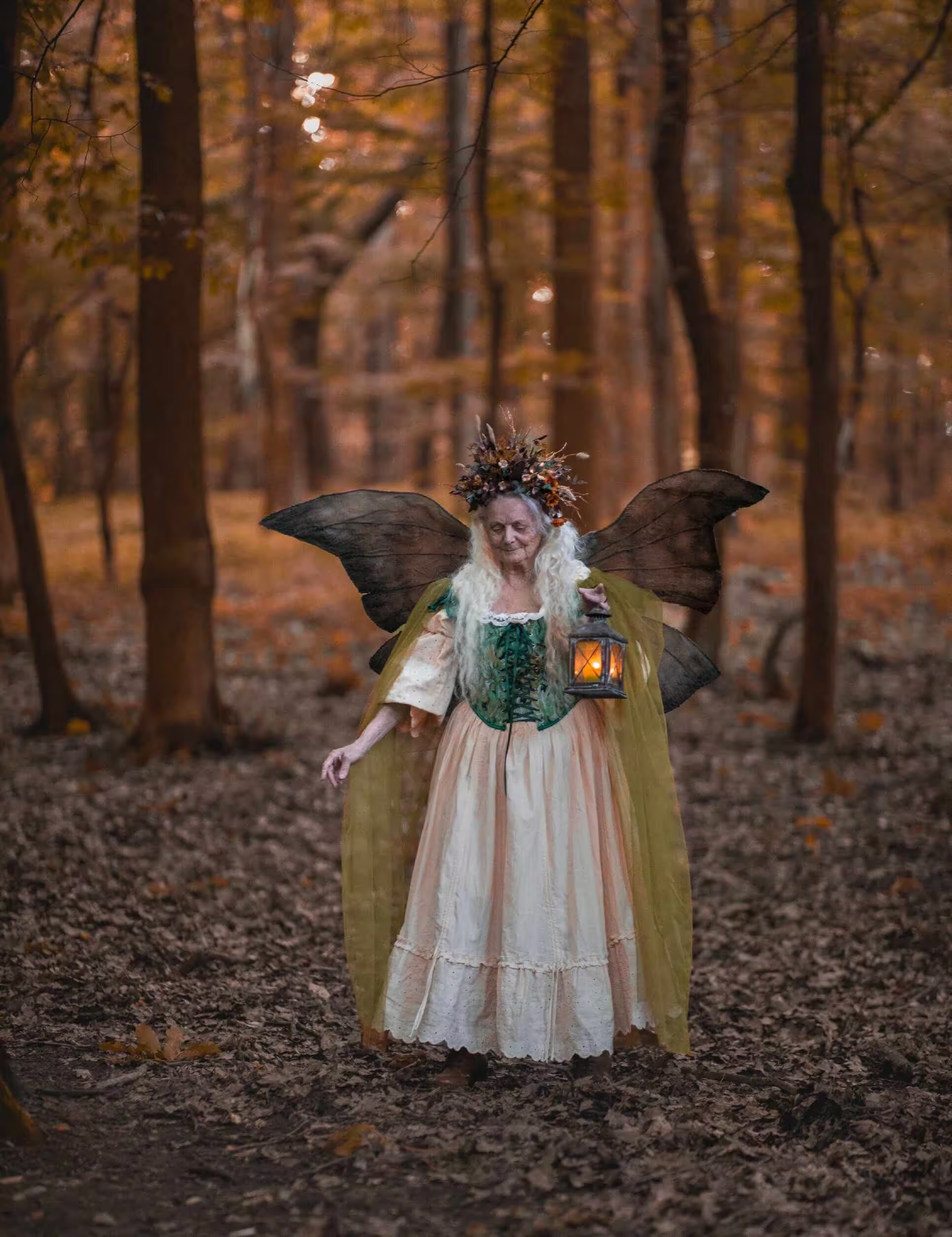
Each cat will ask your business with the Wise Woman of the Forest, and you must state your business as clearly and accurately as you can. Usually the visitors who come are on a quest, and they come to ask the Wise Woman for wisdom. Someone or something (a witch, a snake, a dove) has given them instructions that begin, “Go to the Wise Woman of the Forest and ask her …” Here are some of the questions she has been asked:
Where can I find the garden of the Hesperides?
How can I free my husband from the spell that has turned him into a bear?
Where can I find a pair of shoes that will allow me to climb the glass mountain?
How can I weave a cloak of feathers so I can find my swan wife again?
What is happiness, where does it lie, and how can I get there? How can I defeat death, because I want to live forever?
What is true love and where in the world, or out of the world, can I find it?
If you have legitimate business with the Wise Woman—that is, if you have not come to her simply out of curiosity—the cat will let you enter.
If you enter at the eastern gate, you will see a garden with small flowers—violets, daisies, and primroses scattered across a green lawn. At its center is a sundial that tells all the hours.
Around it, daffodils and hyacinths are blooming, and growing by the wall are cherry and apricot trees, dropping their pink and white blossoms on the grass. The air is filled with birdsong.
If you enter by the southern gate, you will see a garden filled with beds of irises, delphiniums, and foxgloves in full bloom. At its center is a rectangular pool on which float the pink flowers of waterlilies. Next to the wall grow rosebushes, all the beautiful old scented varieties. Honeysuckle twines through the rose canes, its yellow bugles buzzing with bees. Sometimes you can hear a frog croaking to its mate.
If you enter by the western gate, you will see an orchard of apple and pear and peach trees, dropping their ripe fruit on the ground. Along trellises on the wall grow grape vines, with green and purple clusters of grapes hanging down like jewels.
In one corner is a fig tree on which grow figs so sweet that wasps get drunk on their nectar. In this garden, if you stand very still, butterflies will land on your hands and shoulders. At its center is a statue of Pomona holding the Horn of Plenty.
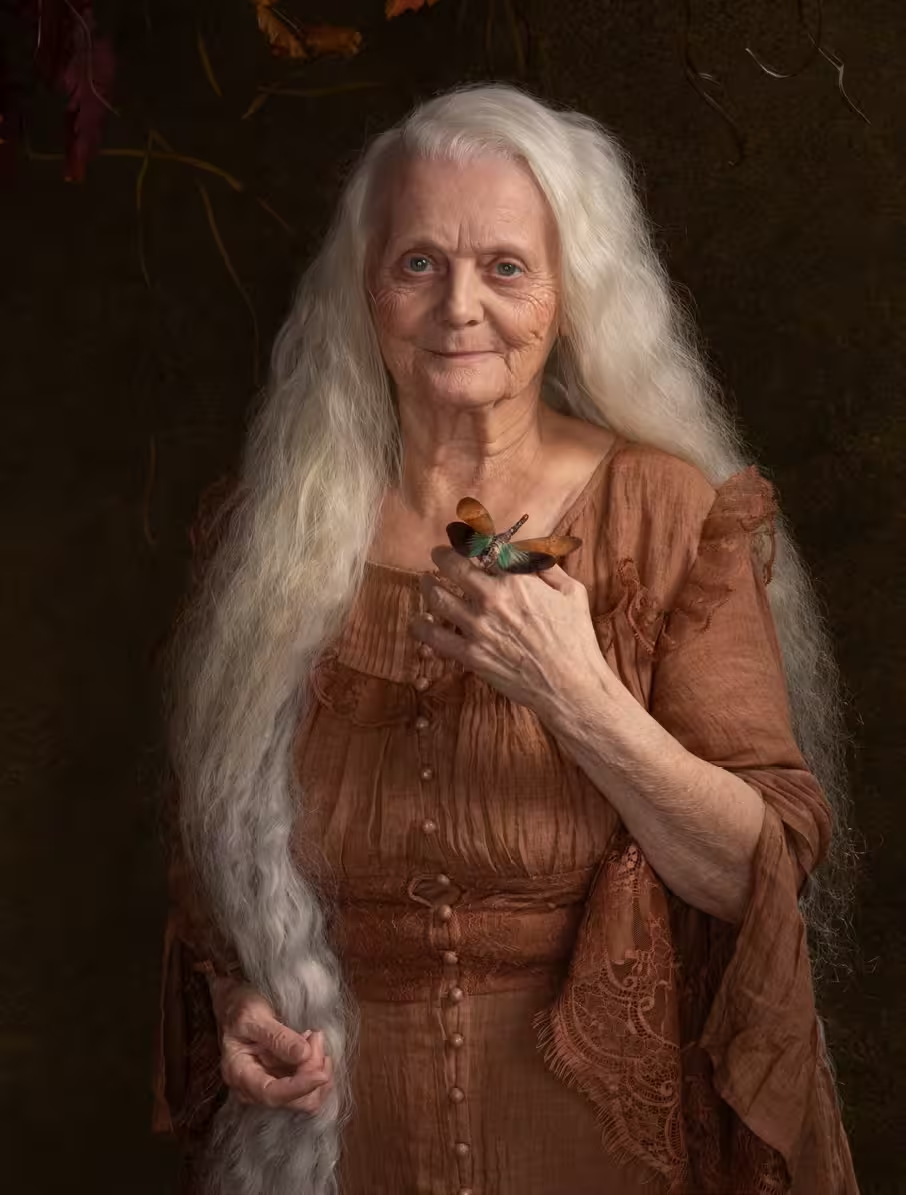
The northern gate leads into an austere garden of dry grasses and bare branches that glitter like gems because every stem and twig is coated in ice. The only sounds are a creaking as the wind moves through the branches, a tinkling as ice falls, the crunch of frost under your boots. At the center of this garden stands a yew tree, still clothed in green needles and red berries, promising that color will return again to the earth.
Whichever gate and garden you enter, you will be led into the castle, where the Wise Woman of the Forest sits in her library. Along the walls of that library are bookshelves rising all the way to the ceiling, so high that the upper shelves can be reached only by ladders. The ceiling is painted to look like the sky—or perhaps it is the sky? Sometimes it’s as blue as the sky on a sunny day, sometimes it’s gray with rain and flashing with thunder, sometimes it’s white with unfallen snow. And the ladders go up and up, so that their tops are hidden in mist or clouds.
The books in that library contain all the wisdom in the world, and if the Wise Woman of the Forest needs to consult any of them, she sends one of her cats up a ladder to fetch the required volume. All of her cats are wise, all are multilingual, and the cats of the library in particular wear small berets with feathers— pigeon or peacock or kingfisher feathers—to distinguish them from the garden or kitchen cats, or the cats who play lutes to amuse the Wise Woman of the Forest when she embroiders the night sky with stars.
At the center of the library is a hearth, and in that hearth burns a fire, pink and orange and violet and blue, that never smokes and never goes out. Beside that fire is where she sits every day, working at her desk, because she is a very busy woman—she always has a great deal to do.
What does she do? you asked. Tell us, oldest sister. Yes, please tell us.
The northern gate leads into an austere garden of dry grasses and bare branches that glitter like gems because every stem and twig is coated in ice. The only sounds are a creaking as the wind moves through the branches, a tinkling as ice falls, the crunch of frost under your boots. At the center of this garden stands a yew tree, still clothed in green needles and red berries, promising that color will return again to the earth.
Whichever gate and garden you enter, you will be led into the castle, where the Wise Woman of the Forest sits in her library. Along the walls of that library are bookshelves rising all the way to the ceiling, so high that the upper shelves can be reached only by ladders. The ceiling is painted to look like the sky—or perhaps it is the sky? Sometimes it’s as blue as the sky on a sunny day, sometimes it’s gray with rain and flashing with thunder, sometimes it’s white with unfallen snow. And the ladders go up and up, so that their tops are hidden in mist or clouds.
The books in that library contain all the wisdom in the world, and if the Wise Woman of the Forest needs to consult any of them, she sends one of her cats up a ladder to fetch the required volume. All of her cats are wise, all are multilingual, and the cats of the library in particular wear small berets with feathers— pigeon or peacock or kingfisher feathers—to distinguish them from the garden or kitchen cats, or the cats who play lutes to amuse the Wise Woman of the Forest when she embroiders the night sky with stars.
At the center of the library is a hearth, and in that hearth burns a fire, pink and orange and violet and blue, that never smokes and never goes out. Beside that fire is where she sits every day, working at her desk, because she is a very busy woman—she always has a great deal to do.
What does she do? you asked. Tell us, oldest sister. Yes, please tell us.
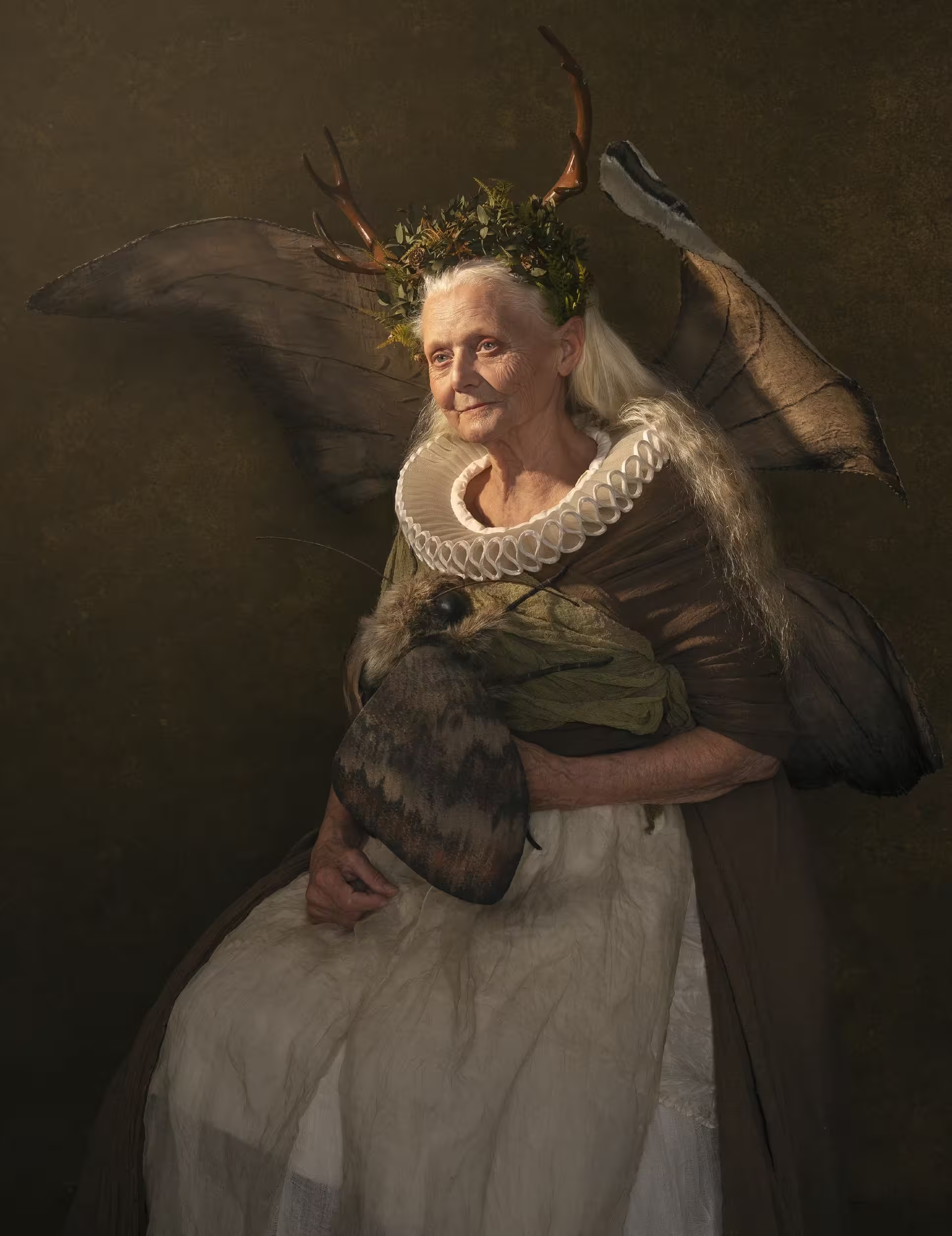
Well, for example, she makes sure the stars are staying in their proper courses and the spiders are spinning their webs as they should. She checks that the leaves are turning the right colors in autumn, that the tides go in and out on schedule, that nightingales sing their songs during the correct seasons in the gardens of Spain and Morocco. She does not let butterflies confuse themselves with moths, or vice versa. She designs the patterns for all the snakeskins, and if the planets need aligning, she takes care of that as well. She makes sure that the universe keeps running the way it ought to, because it needs to be adjusted now and then, like an antique clock. And of course she dispenses wisdom to all who find her castle and ask for it. Although she is as ancient as the universe itself, she contains all the ages she has ever been. If you came to her, you might find a girl playing with agate marbles on the floor, or a young woman occupied with her celestial embroidery, or a middle-aged matron writing with a quill pen in a language older than the stars, or a grandmother telling tales and perhaps jokes to her cats as they listen attentively with their tails wrapped around their paws. At night she sleeps in the highest tower of her castle in a bed made of clouds—or perhaps on the moon. I have never visited her at night, so I tell you only what I have heard. But I know that her nightgown is embroidered with a thousand eyes that open when she sleeps and keep watch for her.
Who is this wise woman? you asked. Yes, who is she? Does she have a name?
She has at least as many names as there are stars in the sky, I answered. And probably more. I call her Mother-of-All, and she is your mother and mine. Now go to sleep, Spring. Go to sleep, Summer. Go to sleep, Autumn. It is past your bedtime, and if the Wise Woman of the Forest were here, she would scold you for still being awake. I have work to do, so let me cover you up.
You have had your story. It is time to dream.




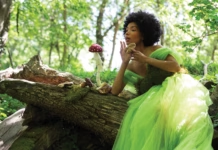

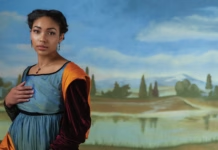



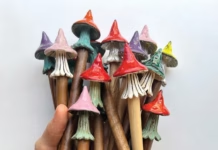


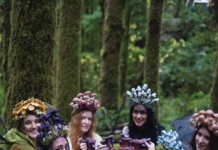

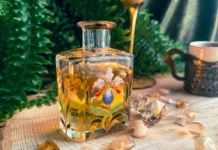
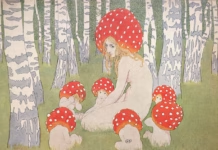
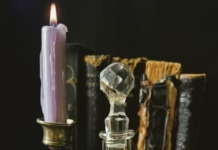
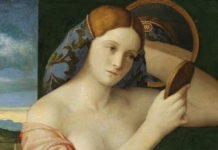


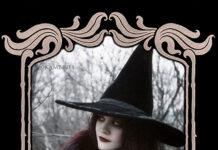

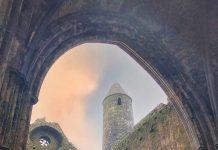
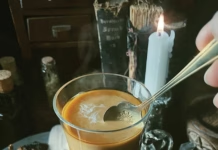
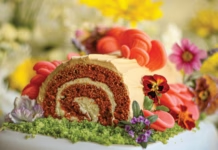
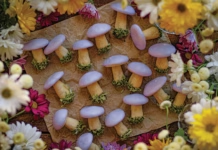


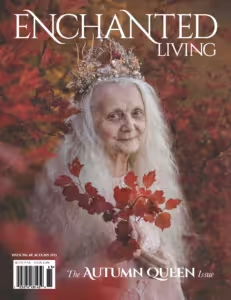 Enchanted Living is a quarterly print magazine that celebrates all things enchanted.
Enchanted Living is a quarterly print magazine that celebrates all things enchanted. 